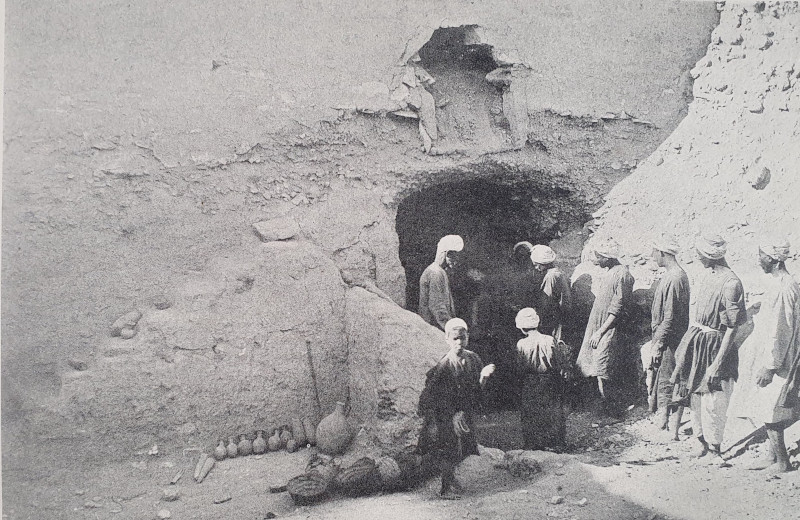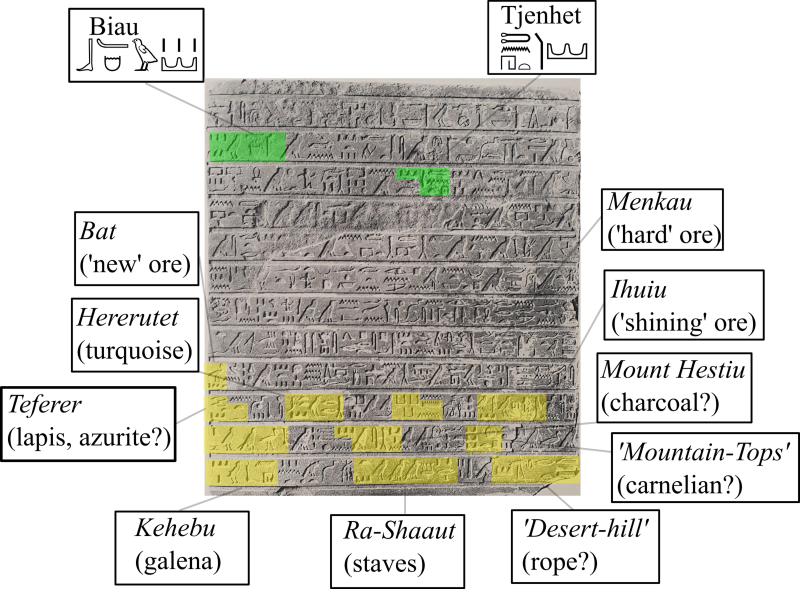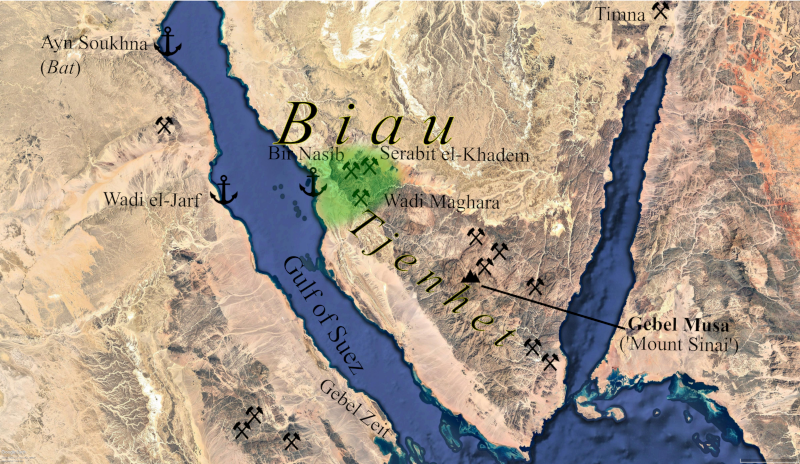
February 2023
Vol. XI, No. 2
The Earliest Mention of the Placename Sinai: The Journeys of Khety
By Julien Cooper
Well before Moses ascended "Mount Sinai" and received the revelation from God, Egyptian officials penetrated the rugged vales of the Sinai Peninsula in search of minerals, chiefly copper and turquoise. One Egyptian official traversed the peninsula more than any of his compatriots: Khety, a "seal bearer" and "overseer of quarries" who lived in the Egyptian 11th Dynasty (c. 2150-1990 BCE).

Our knowledge of Khety's journeys begins with the famed Howard Carter. Before Carter discovered the tomb of Tutankhamun in the Valley of the Kings, he spent time digging in the nearby necropolis of Birabi on the Theban mountain. In the 1913-1914 season, he excavated Khety's tomb and unearthed several inscriptions from the doorway, including a rectangular limestone stele that stood to the left of the tomb entrance (Fig.1). The task of translating the text was given to the philologist Alan Gardiner who published it in a short article entitled "A tomb of a much-travelled Egyptian official" in 1917.


Fig. 3: Expedition stelae like this one (no. 112) are common at the turquoise mines at Serabit el-Khadem. They reference foreign expedition members, including this rare example of a "brother of the ruler of Retjenu (Canaan)" named Khebded, depicted riding a donkey. (Gardiner and Peet 1917, pl. 37).
Khety's Exploits in the Sinai
Gardiner noted the exceptional nature of this "much-travelled" official, who boasted of his journeys to distant desert quarries and mines. Such exploits are often described in Egyptian tomb biographies, but Khety's biographical text includes unparalleled detail due to the specificity of the places he mentions (Fig. 2). His travel narrative opens with a general statement:
I am a god's seal-bearer in making powerless the hill-countries. When I was in Biau, I inspected it, and I travelled-round the hill-countries of Tjenhet.
Khety subsequently proclaims other general exploits, his excavation of mining shafts, his vanquishing of the Asiatic enemies, and later his procurement of precious materials and metals from specific places: turquoise from Hererutet, copper from Bat, Menkau, and Ihuiu, galena (Egyptian eye-paint) from Kehebu, and staves from Ra-Shaaut, amongst other exotic resources. Some of these places can be located with confidence due to their mention in other texts or as the known location of minerals (all in the southern Sinai Peninsula or its adjacent shores), but other placenames are unknown. Two place names in the text, Tjenhet and Ihuiu, record names from foreign languages. It is Tjenhet which interests us here.
Khety's opening statement—his inspection of Biau and travelling round Tjenhet— acts a frame and heading for his subsequent travels. Biau, literally "mining-country", is the regular Egyptian word for the entire copper and turquoise mining area of the southern Sinai where Egyptians journeyed regularly since the Early Dynastic (c. 3100 BCE). Unlike Biau, the placename Tjenhet has no meaning in the Egyptian language and is never encountered again in attested Egyptian texts. As a foreign word, the name almost certainly stems from a locally-spoken Semitic language. Semitic speakers are well-known in the Sinai desert and are mentioned in the Egyptian expedition inscriptions erected at the turquoise mines (Fig. 3). Such people are notably credited by scholars with the creation of "Proto-Sinaitic" script by adapting Egyptian hieroglyphs to suit their own tongue (Fig. 4). This script was the precursor to Hebrew and Phoenician scripts.
Ṯnht = "Sinai"?
The puzzling placename on Khety's stele is spelt in Egyptian hieroglyphs as follows:
The first four signs are consonants and the last two signs are non-phonetic classifiers that tell the reader that this placename was a foreign land. The name is transcribed as Ṯnht in Egyptological transliteration, regularized in standardized translations as "Tjenhet". Egyptian ṯ represents a sound close to the "ch" in chip, usually transcribed as tj by Egyptologists. In trying to find a Semitic etymology for this placename, one is presented with the problem that there is no such ch sound in Semitic languages of the Levant. However, analyses of hundreds of Semitic loanwords in Egyptian texts shows that Egyptians did use their ṯ sound to transcribe a Semitic sound, namely s, the sound represented by the Hebrew letter samekh (ס).

Fig. 4: One of the so-called "Proto-Sinaitic" texts from the mines at Serabit el-Khadem (No. 349). While the symbols are reminiscent of Egyptian hieroglyphs, the text would be quite unreadable to Egyptians and encodes a Semitic tongue. (Gardiner and Peet 1917, pl. 83).
The reasons why Egyptians used their letter ṯ for Semitic s are complicated, but most linguists conclude that the sound of samekh probably had an original and older pronunciation of a sound like ts [t͡s] [1] (like cats) that later shifted to s [s] by the time of Biblical Hebrew. For Egyptian ears, this "old samekh" sound was closest to their ṯ. So when Khety's scribes and biographers transcribed Ṯnht they probably heard something like t͡snht [2]. As time wore on and sounds shifted, such a name would be later pronounced as snht. The final consonant -t in this placename is a suffix, a common element in Bronze Age placenames across Canaan and adjacent lands that is often dropped by the time of Biblical Hebrew. Taking all this into account, the "later" pronunciation of snh recalls the name "Sinai", Hebrew Sînay סיני. The reason why this equation of "Ṯnht equals Sinai" has escaped the notice of Egyptologists and biblical specialists alike has much to do with the ways in which the placename is regularly transcribed in Egyptian translations as Tjenhet or Thenhet, a pronunciation that seems wholly alien to any Semitic language like Hebrew.
Khety's Ṯnht was a large and mountainous land, which one "travelled round" (deben), a rare verb choice which stresses its expanse. It was large enough to contain multiple khaset or "hill-countries", echoing the Biblical Hebrew expressions har Sînay "Mount Sinai" or midbar Sînay "wilderness of Sinai". Later in his biography, Khety describes the procurement of copper and other precious materials from specific mines, meaning Ṯnht likely designated the parts of the modern Sinai Peninsula from where these materials could be obtained. This would include the nearby "Egyptian" mines at Serabit el-Khadem, Bir Nasib, and Wadi Maghara but also the hills further east near Saint Catherine's monastery where Itzhaq Beit-Arieh identified mining and smelting sites at places like Watia Pass, Wadi Ahmar, and Wadi Samra.
Like the Egyptian expression Biau, Ṯnht must refer to the southern parts of the Sinai Peninsula that contained mineral wealth (Fig. 5). The reason why this toponym occurs only once in attested Egyptian texts is simple, it was a foreign word for the larger reaches of the peninsula. When Egyptians journeyed to Sinai they visited only those mines around Serabit el-Khadem and Wadi Maghara, calling the area Biau. Khety, stressing his pioneering, seems to have travelled here but also beyond these lands, recording Egyptian controlled mines as well as mine-sites with foreign names like Ihuiu.

The Location of Biblical Mount Sinai
What can the mention of "Sinai" in Khety's biography tell us about the location of biblical Mount Sinai? The location of this sacred place is one of the thorniest problems in the historical geography of the bible and has been debated for centuries; James Hoffmeier's book, Ancient Israel in the Sinai: The evidence for the authenticity of the Wilderness Tradition, canvasses the varying traditions and debates. As a crescendo of the Exodus story and the place where Moses received the ten commandments, the modern location of this sacred mountain is of obvious importance to Jews, Christians, and Muslims alike.
But the tradition of locating the Mount Sinai of the Hebrew Bible with Gebel Musa, the modern "Mount Sinai", only goes back to Christian times c. 4th Century CE. This has worried many scholars, who saw such an equation as an anachronistic invention of Christian monks and pilgrims, with no earlier material or proof for a local "pre-Christian" tradition at Gebel Musa (Fig. 6). As a result, alternative proposals have proliferated and gained in popularity, with some locating 'Mount Sinai' in the northern parts of the Sinai Peninsula, the Wadi Arabah, Jordan, or even Saudi Arabia.
While it is difficult to link two place names separated by more than 700 years, the phonetic and geographic similarities between Ṯnht and Sînay would be amazingly coincidental. If Khety's Ṯnht is the early form of "Sinai", then this suggestion supports the orthodoxy (to excuse a pun) of the early Christians who located biblical "Mount Sinai" in the southern parts of the Sinai Peninsula, be it Gebel Musa or any other nearby peak like Gebel Serbal or Gebel Katerina. It is worth recalling that place names are stubborn and tenacious elements in language that can survive for a long time with little change. Many other Semitic place names like Ashqelon or Pella are similarly recorded in Egyptian documents of the Middle Kingdom and survive in a similar phonetic form to the present day, lasting for over 4,000 years. Simply put, when Khety journeyed to the mining country, well before Moses trod its mountains, local people already called it something close to Sinai.
Another implication of this equation is the etymology of "Sinai". One of the most commonly espoused origins for the name is a link to the Hebrew word snh "bush", an idea that finds its origin in the biblical narrative itself regarding the famed burning bush from which god spoke to Moses; although many other etymologies have been proposed, such as a link to the wilderness of Sin. The "bush" etymology is perfectly supported by this transcription of Ṯnh(t), although it can only be guessed how a series of sound and dialect changes may have later reproduced a name like Hebrew Sînay.
Julien Cooper is an Egyptologist at Macquarie University (Sydney) and United International College-Beijing Normal University, Zhuhai (China). He is the author of Toponymy on the Periphery: Placenames of the Eastern Desert, Red Sea, and South Sinai in Egyptian Documents from the Early Dynastic until the End of the New Kingdom. (Brill 2020).
The author is grateful to Zachary Thomas for providing comments on a draft of this article.
Further reading:
Gardiner, A. 1917. "The tomb of a much-travelled Theban Official", Journal of Egyptian Archaeology 4: 28-38.
Gardiner, A.H. and Peet, T.E. 1917. The Inscriptions of Sinai. Part I: Introduction and Plates (London).
Beit-Arieh, I. 2003. Archaeology of Sinai: the Ophir expedition (Tel Aviv).
Hoch, J. 1994. Semitic Words in Egyptian texts of the New Kingdom and Third Intermediate Period (Princeton).
Hoffmeier, J. 2005. Ancient Israel in Sinai: The Evidence for the Authenticity of the Exodus Tradition (Oxford).
Tallet, P. 2012-2018. La zone manière pharaonique du Sud-Sinaï (IFAO).
-- Sent from my Linux system.

No comments:
Post a Comment